It is pretty normal to be rather worried about all the precautions you need to take after a hip replacement surgery, and in particular to be afraid of dislocating the new hip in the first few months. I know that in my 93 yr old mom’s case, we were given a lot of advice on how she should sit and stand correctly, especially when using the toilet, and you really don’t want to get it wrong
Generally speaking, the greatest concern that you have using the toilet after a hip replacement is not causing yourself any injury when sitting down, and standing up from the toilet.
When choosing a raised toilet seat, you need to know the support it offers, what the height is, whether it is height adjustable, the weight capacity, are there armrests, and is there a mechanical lift-assist function.
Buying the right type of raised toilet seat can get rather confusing. It all depends on the age, physical condition, size, height, and weight of the user, and of the space around the toilet in question.
So keep reading to see the differences between the 6 most popular types of raised toilet seats, and my top recommendations for each one.
1) Raised (or elevated) toilet seats with safety frames
Seats with safety frames are a great option for anyone, but especially for someone who is elderly, fragile or suffering from problems with mobility or vision. The frames handles are larger and easier to take hold of, than models which physically attach to the toilet, and some come with high vision blue armrests making them easier to see.
The frames have adjustable leg height, which means that over time if need be, you can raise or lower the seat height, unlike models which attach to the toilet with a fixed height. Most frames have adjustable legs, giving a seat height range from 18′ to 21″.
The frame is what holds the seat, and your weight is evenly distributed over the 4 legs, so unlike some models of raised toilet seat which attach to the toilet bowl, these do not wobble, and so inspire more confidence.
To use a raised toilet seat with safety frame, first you lift your toilet seat and lid to the vertical position. Next, check the seat is at the correct height for the user to be in a seated position where their knees are no higher than their hips (adjust the seat height by adjusting the length of the legs).
The correct seat height for after a hip replacement is typically referred to as the 90 degree rule. A full explanation can be found below.
The seats are also all open at the front to give greater access for wiping, and this will be of great help after a hip replacement, especially if you are using a wand type device to clean yourself.
These seats weigh around 7 – 10lb, so they can be simply picked up and removed in an instant, when you have guests or other people who don’t need to use it, unlike all raised toilet seats which attach to the toilet bowl.
The only downside that I can think of, is that there is no backrest on most models.
This can be a bit off-putting if other people are using the toilet without the raised toilet seat, as when you sit on the raised toilet seat yourself, if you lean back, you will be leaning up against the underside of the toilet seat that they are using – but you can just have a cover on the toilet seat, or clean like crazy.
The weight capacity of raised toilet seats with safety frames ranges from 250lb to 400lb.
To get an idea of the different models and their weight capacities, across all types, I have a huge list article of over 180 examples with their weight capacities, and you can look at that here, “Raised Toilet Seat Weight Capacity: Over 180 Examples”.
They usually range in price from $104 to $160.
My top pick for individuals up to 350lb is the Platinum Health Ultimate Raised Toilet Seat
My top pick for especially tall individuals (max seat height 20.5″ – 27.5″) is the OasisSpace Stand Alone Raised Toilet Seat With Hard Seat
My top pick for individuals from 350 – 400lb is the HEAO Shower chair and raised toilet seat
2) 3-in-1 bedside commode
Standard 3-in-1 bedside commodes are another great option as a raised toilet seat after a hip replacement, and in particular for anyone with mobility problems, or the elderly.
Bedside commodes are basically a toilet without running water, and come in the form of a chair with a bucket under the seat. This bucket can be removed, and the frame and seat can be placed over a normal toilet and used as a raised toilet seat.
And if at first you can’t get to the toilet easily, you can use it as a commode in anywhere you wish.
The bedside commodes have wide frames, with nice big armrests, making it easy to grab hold of them, and to use the arms to sit and stand, plus they come with a lid which acts as a backrest !
For use over the toilet, the leg height is adjustable, typically giving a range of seat heights from 17″ to 23″.
If you want to learn more about using a bedside commode as a raised toilet seat, you can find out lots in my post – “Can A Bedside Commode Be Used Over A Toilet ?”
You can check how to find out the correct seat height for after a hip replacement further down in this post.
For individuals over 300lb, there are bariatric 3-in-1 bedside commode, which are discussed below.
My suggestion for a very affordable bedside commode to use as a raised toilet seat is the Medline 3-in-1 Steel Folding Bedside Commode – Model No. G1-200×1.
3) 3-in-1 bedside commode with lift-assist mechanism
This is a wonderful option for individuals who are frail enough to need extra help, with sitting and standing, other than just the obvious hip replacement issues.
You can buy very expensive special lift-assist mechanisms, electric or hydraulic, for the toilet, but in this case, this is a particular design of bedside commode with a spring-loaded seat, which gives a little extra help when sitting down and standing up., and which can be used over a toilet.
Do bear in mind that because of the spring-loaded mechanism, the maximum weight capacity of the seat is slightly lower than most standard models at 285 lb
The wide arms ad frame of these seats make coordination easier for a person who is having difficulties with sitting, and the seats are extremely solid.
When the user is about to sit back, the seat is in raised at about a 45-degree angle, and will help to take some of their weight as they go downwards.
At the moment the user wishes to stand, they will press a release button which will release the lift-assist mechanism on the seat and give some lift, helping them to stand.
The legs are height adjustable, giving a seat height rang from 21.5″ to 25″, and with all the other seats with a frame, you set the height of the legs, and then place it over the toilet.
To use these seats over the toilet, first remove the commode pale, and then as with all the other frames, put your actual toilet lid and seat into the upright position, adjust the frame leg height to the correct height for the user’s hip (as outlined below), and place the seat over the toilet
As with all the seats with frames, when you don’t want it there, you can whisk it away in a flash.
There is only one model with this mechanism, and the price is around $260, which is hundreds of dollars cheaper than other electric and hydraulic lift mechanisms available.
My suggestion for a raised toilet seat with a lift-assist mechanism is the Platinum Health GentleBoost 3-in-1 Commode and Shower Chair.
4) Toilet riser with armrests
Toilet risers are another very solid form of raised toilet seat and, with armrests, are a very good option of raised toilet seat for all but the most elderly seniors after a hip replacement, or individuals over 250lb to 300lb (depending on the brand).
Unlike the other types of seat discussed so far, these seats attach directly to the toilet, have no legs, or frame to speak of, but they can come with armrests.
A toilet riser is a more, or less, oval ring of plastic which is installed under your existing toilet seat to raise it up by 3.5″, using the existing toilet seat bolt holes.
A person with a hip replacement is really best advised to use a riser with armrests, unless they already have grab bars, or a safety frame around their toilet. You need to have armrests to push up from when you rise to stand, and to take your weight as you lower yourself to sit.
The downsides of risers are that they are not height adjustable, they take some time to install, they cannot be whisked away when you have guests, they are all one fixed height of 3.5 “, you have to know which toilet shape you have, and they have a maximum weight capacity of 300 lb.
As, I just noted there are no models with a greater weight capacity than 300lb, and it is also to be noted that they do not have the width between the armrests that you find on raised toilet seats with safety frames, or on 3-in-1 bedside commodes for larger hips and thighs.
You must also be careful that you get the right form of riser for your toilet.
There are two shapes – standard, which is rounder, and elongated, which is more oval. You do need to make sure you get the right type.
My suggestion for a riser is the Vive 3.5 Inch Toilet Seat Riser with Handles (Model No. LVA1071S (standard toilet) or LVA1071E (elongated toilet)
5) Front locking raised toilet seats with armrests
Front locking raised toilet seats, are a good medium term option for a raised toilet seat after a hip replacement, for an adult who is otherwise in good shape.
These seats are made from compressed plastic, and attach easily to the toilet bowl once you have put the seat and lid of your toilet in their upright position, adding 4″, 4.5″, or 5″ in height to your toilet, depending on the model.
There is a flange at the back of the seat which inserts under the inside of the toilet bowl rim to stop it from tipping forwards, and a plastic clamp at the front. They do not though attach as securely as toilet risers.
Front locking seats are typically advertised as being universal, and I tried one such seat for my Mom, and we found that it did wobble a bit, and were not really suited to someone who was elderly.
You can get them with armrests, which as I have said already is, in my view, essential for someone using a raised seat after a hip replacement.
The models are not as wide as any of the seats with frames, and so are not suited to larger individuals, as well as having weight capacities which vary between 250lb to 300 lb.
They do come off the toilet very quickly though – you just undo the front locking bolt and lift the seat off.
They usually range in price from $35 to $150.
My pick for a front locking toilet seat for after a hip replacement is the Drive Medical Premium 5″ Plastic Raised Toilet Seat w/Armrests
6) Bariatric raised toilet seats
For larger individuals who weigh over 400lb, the main type of seat which adds more than 2″ of elevation to a toilet is a bariatric 3-in-1 bedside commode.
These are extremely strong, and are basically a larger version of the standard bedside commodes which I discussed earlier.
The seats are suited to younger and older individuals, as they have large armrests and are extremely sturdy.
There are really only two types in terms of design which have a metal frame and can, be placed over a toilet once the bucket, or pale, has been removed, and the legs have been adjusted to the right height.
There are those models which look exactly like a standard commode, just bigger, and there are other models where the seat is more like a bench seat, and it goes across the whole width of the frame, but they work in exactly the same way.
Where the standard models weigh 5 – 7 lb at most, these seats weigh around 20 – 25lb, which may make them a little more tricky to whisk away when you have guests
The only problem you may have with these seats, is the size, as they are heavier and wider to accommodate greater weight and wider hips and thighs.
My suggestion for a raised toilet seat with a weight capacity of 500lb is the Nova Heavy Duty Drop-arm Commode 8583
My suggestion for a raised toilet seat with a weight capacity of 1000lb is the Drive Deluxe Bariatric Drop-Arm Commode 11135-1
If you want to see the full list of bedside commodes available and their weight capacities, you can go to my post – “Bedside Commode Weight Capacity: A Guide With Over 140 Examples and Illustrations”.
Discuss what type of raised toilet seat you need with your surgeon
Before you have your surgery, you may want to discuss with your doctor what type of seat they recommend for you to get.
Now, in my mom’s case, she had her surgery at 88 yrs old, and we decided to get her the bedside commode, as we felt she would need all the support that came with that.
We also received instruction, at the hospital, in how to sit down and stand up, after the surgery, and which helps to avoid any injuries.
My mom was also advised to use a walker to help her back up to the seat, before sitting down, so that she could transfer her weight from the walker to the raised toilet seat armrests, and also when standing up.
You should be getting all the guidance you need from your surgeon’s team.
Do I need a raised toilet seat after hip surgery ?
If your toilet seat level is lower than the height of your knee, you will need a raised toilet seat of some kind after hip replacement surgery.
After hip surgery, the muscles around the hip will remain weakened with very little tone for a while, which can cause the stability of the joint may be lessened.
With this weakening of the muscles, there may be a small risk of dislocations.
The 90 degree rule
Patients are usually advised, to not bring their knee of the operated hip/leg up close to their body, as this small chance that this can result in a dislocation of the new hip replacement.
The illustration below demonstrates the rule – the knees should be brought no closer to the chest than the angle below – at least for the period of the healing of the weakened muscles, and during the physical therapy building those muscles back up.
The 90 degree rule applies more to individuals who had a “posterior approach” (back of the hip) surgery, than to those who had what are called “anterior” (front of the hip) or “lateral approach” surgery.
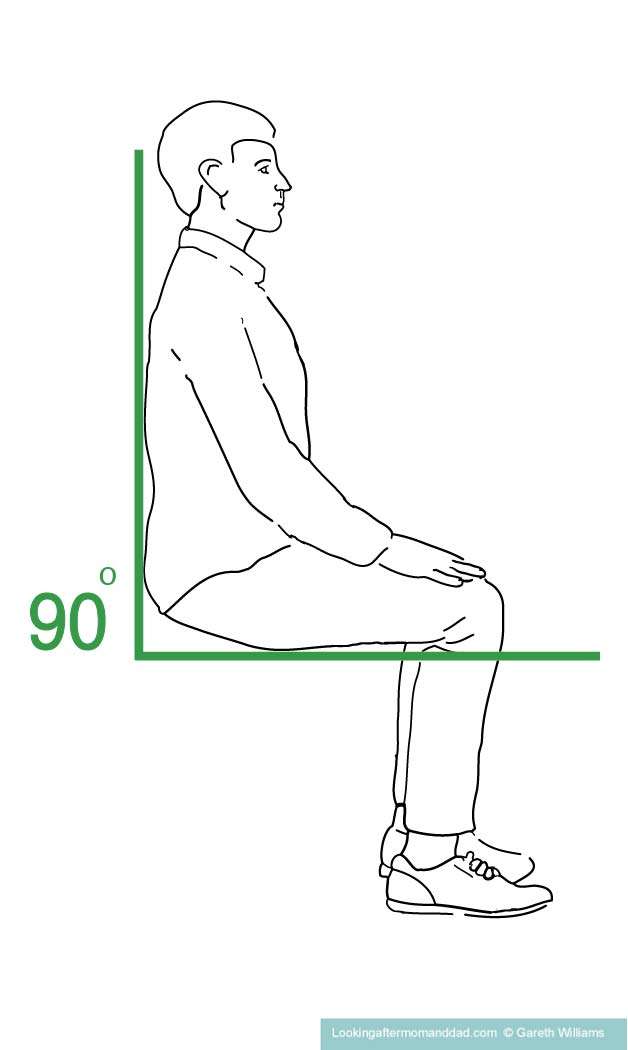
You also want to avoid bending forwards when you are seated, as this will bring the chest closer to the knees.
You can see this below.
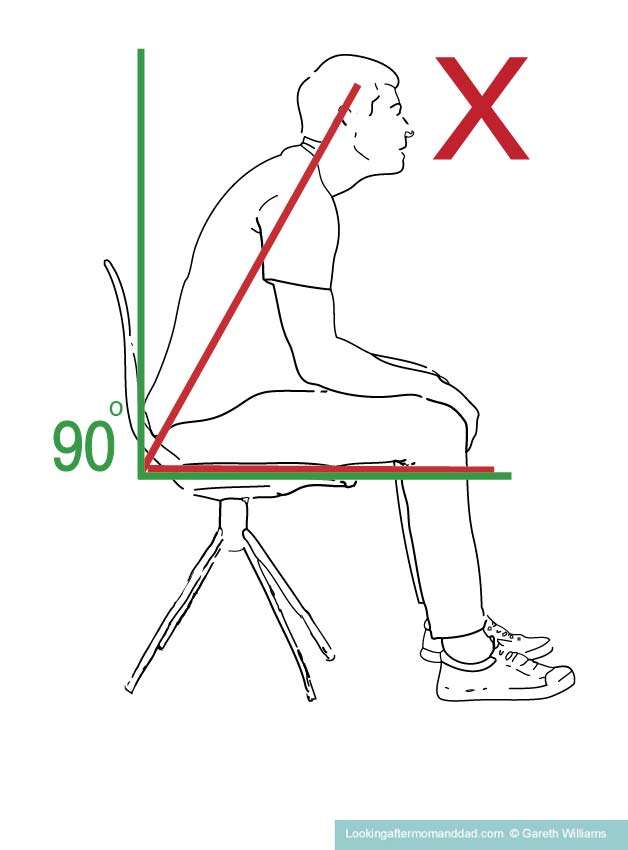
Do not lean forwards like this
One occasion when you may be at risk of breaking the 90 degree rule, is when you sit on a low seat – lower than the height of your knee – or, when you bend forwards a great deal, and both of these may occur if you have a low toilet seat.
For this reason you will be advised not to use seats which are lower than the level of the back of your knee.
As a rule, the lower the seat a person sits on, the more they will need to lean forwards to be able to stand up, and this is where you will break the 90 degree rule.
You can see from the illustration below, that with the bottom lower than the knees, it would be virtually impossible to sit, and maintain a good distance between the knees and chest.

Do not sit with the knee above hip height or lean forwards
For this reason, when you are sitting after having had a hip replacement, your thighs knees should always be at a 90-degree angle to the torso, or more, and that is why you should use a raised toilet seat if your toilet seat is lower than your knee level.
In the illustration below, you can see that the hip is slightly higher than the knee which is fine, but the character is leaning forwards, and this is, again, not advised.
The torso, in this situation, should be no closer than the 90 degree line, and ideally the position should be at about 110 degrees to the thighs and knees.
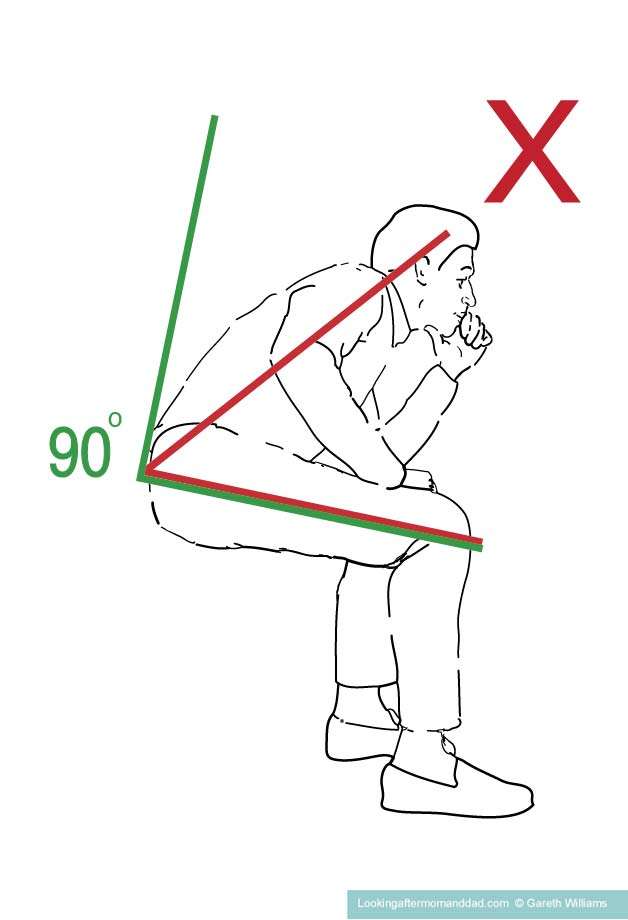
Don't lean forwards like this
Armrests can be extremely helpful with sitting and standing correctly.
Obviously, when sitting down and standing, the armrests on a raised toilet seat, or chair, will help a person to keep their balance.
Less obviously, they will make it much easier to sit and stand correctly, especially to stand.
With the support of armrests, the user can push up vertically, and not lean forwards, as they would have to without armrests, to build the momentum to get to the standing position.
The armrests, effectively, help you to maintain the correct posture to avoid injuries.
Don’t sit with your legs crossed after surgery
After surgery, when you are sitting, avoid crossing your legs.
This is not going to last forever, but in the first few months your doctors are going to want you to keep your legs straight, and not to turn them inwards in any way.
Your doctor will tell you when you can stop being so strict about this.
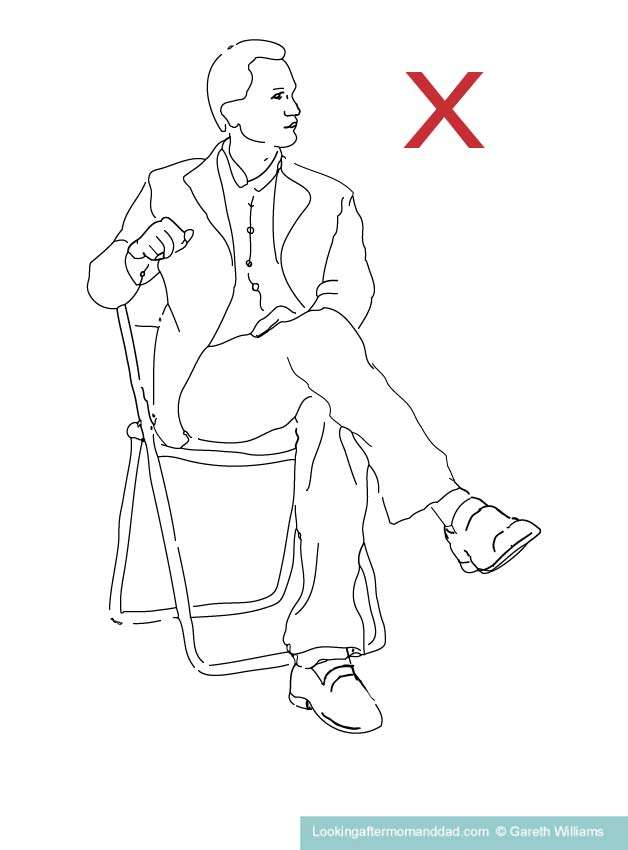

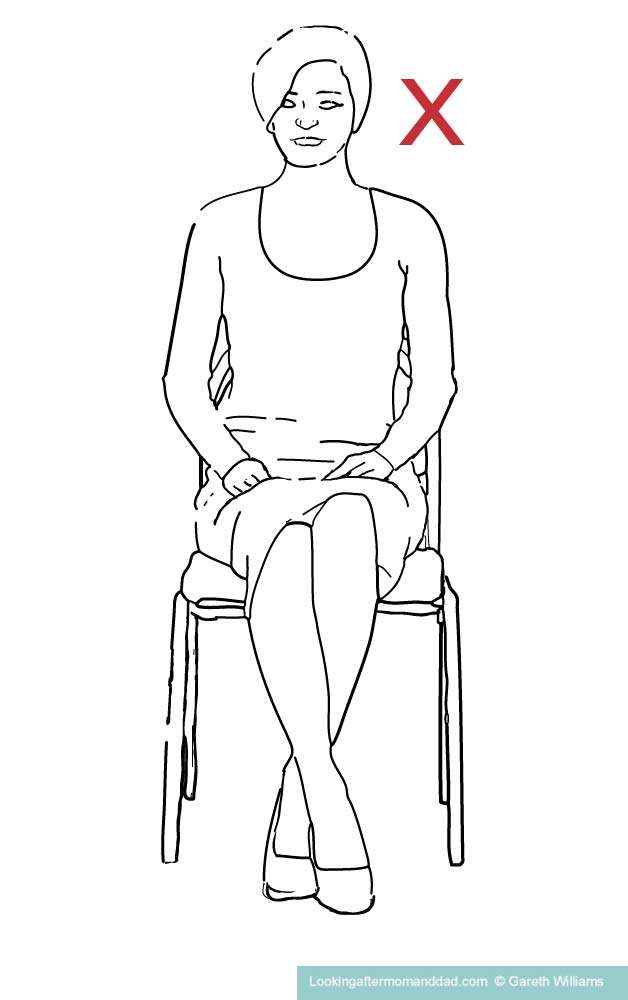
While you are looking for raised toilet seats, there is lots more that you can do to make your bathroom a safer place for seniors, or anyone else with mobility issues.
To find out all the different things you can do, to have an instant impact on bathroom safety, take a look here, “54 Bathroom Safety Tips For Seniors – A Helpful Guide”.
How high should a toilet seat be after a hip replacement ?
The height of raised toilet seat that you will require is very easily calculated.
1. Measure the height of the back of your knee where it bends, from the floor – this is the minimum height that you want your toilet seat to be at.
2. Measure the height of your toilet seat, and subtract that from the height of your toilet knee, and this will give you the height of raised toilet seat that you need.
If you want to learn more about how to measure a toilet for a raised toilet seat, I have an article explaining how to check and measure the toilet to see the size of the bowl, and also how to measure yourself to see what height of raised toilet seat you need.
You can find that article here – “How To Measure For A Raised Toilet Seat”.
For how long should you use a raised toilet seat after hip surgery ?
This is really a question for your surgeon or doctor.
In general, it is somewhere between 6 and 10 weeks, but it will depend on the strength and age of the patient.
This is not really the type of information you should be getting from the internet, as only your doctor knows how you are progressing, and what your capacities for recuperation are.
My elderly mom has not stopped using the raised toilet seat – it was a bedside commode in her case – and it has been sitting over our toilet for almost 4 years now.
Some older adults may just find that the raised toilet seat makes the toilet much easier to use, regardless of whether they still need to use one.
How to sit on a raised toilet seat after a hip replacement
What is most important, is that you learn how to sit down, and stand up properly, immediately after your surgery.
On arrival at home, the individual who has had the surgery, and the caregiver, need to know how the sitting on the toilet, and the getting up from the toilet, are done, as this is the best way to avoid injury.
As I noted earlier, mom was advised to use a walker, to help her back up to the seat before sitting down so that she could transfer her weight from the walker to the bedside commode armrests, and from the commode to the walker when standing up
***Please note, this set of instructions is for those individuals who are using a walker to help them to sit on any form of raised toilet seat with armrests – I would not use one without armrests, and without legs.
To sit down on a raised toilet seat with armrests after a hip replacement
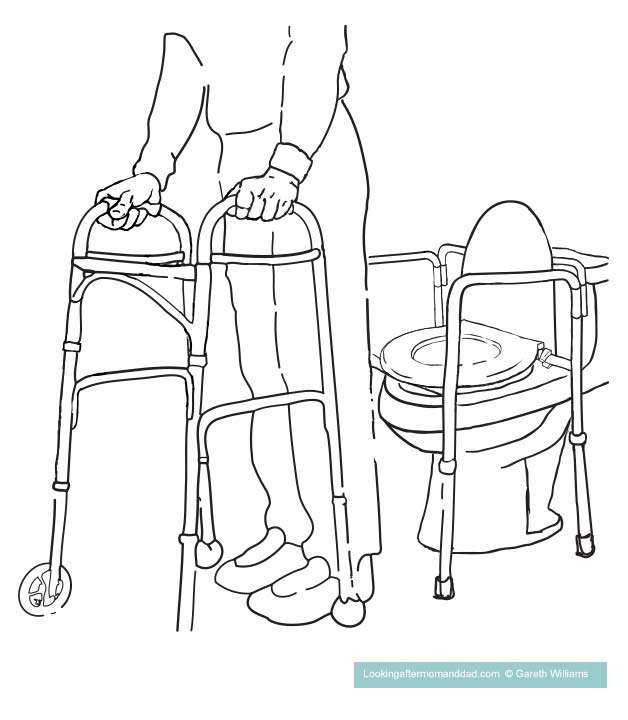
Step 1
Back up to the raised toilet seat with the aid of a walker
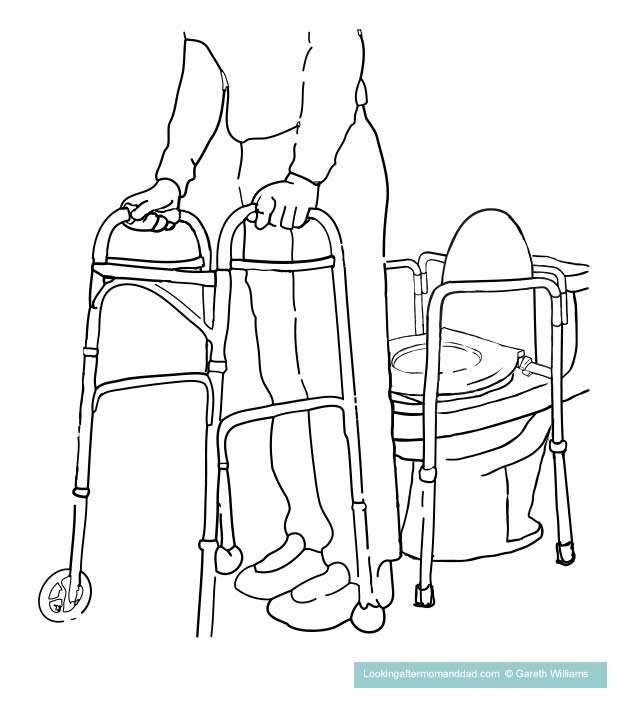
Step 2
Stop backing up to the toilet when you feel the seat against the back of your legs.
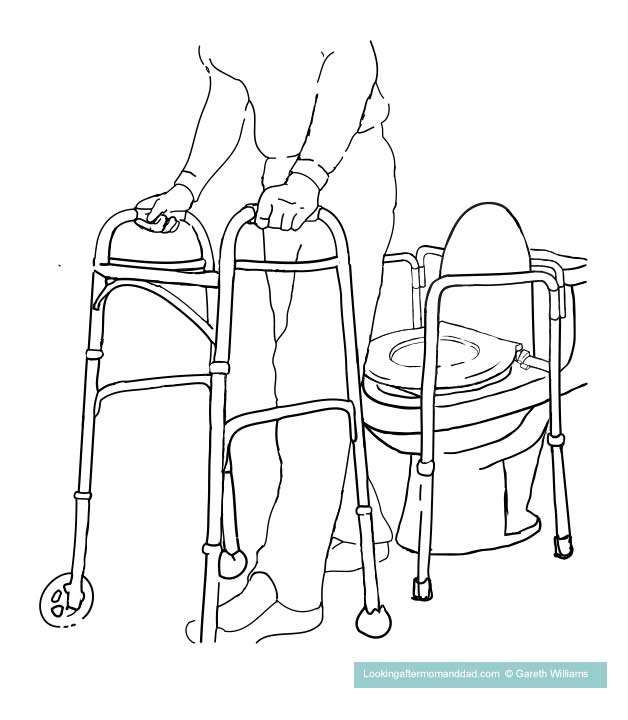
Step 3
If you have any clothes you need to lower, this is the time to do that with one hand holding on to the walker, on the side of the operated leg.
Now extend the involved leg slightly out in front of you.
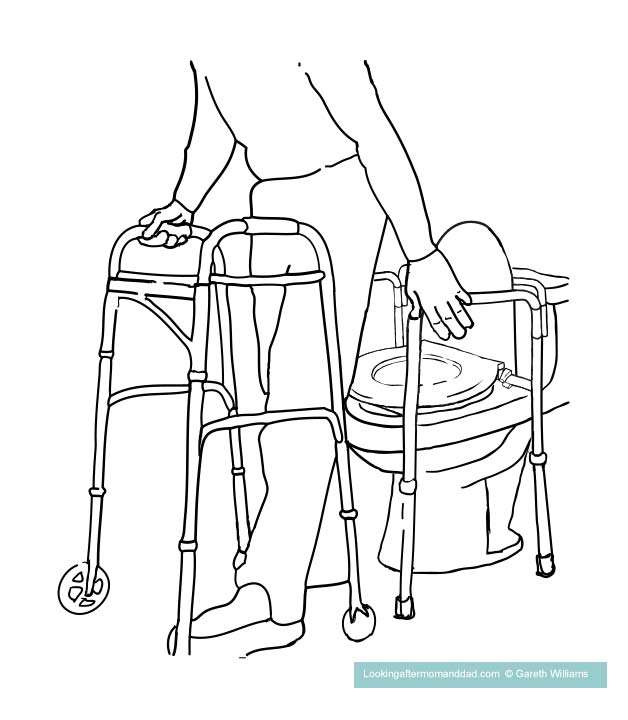
Step 4
Reach back for the armrest of the raised toilet seat on the same side as the operated leg.
Keep hold of the walker with your other hand until you have the hold of the armrest with the hand on the side of the operated leg.
Once you have the armrest in your grip, you can let go of the walker on the side of the non-operated leg, and take hold of the armrest on the raised toilet seat on that side, and sit back onto the seat, using your arms and your good leg to take your weight.
As you sit down, do not bend forwards, just take your weight straight down through your arms keeping a nice straight back.
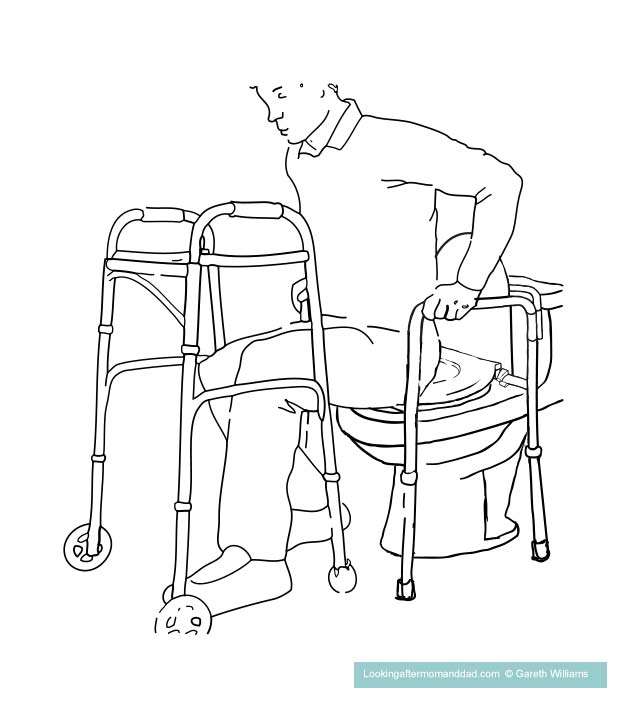
Step 5
Sit on the front of the raised toilet seat.
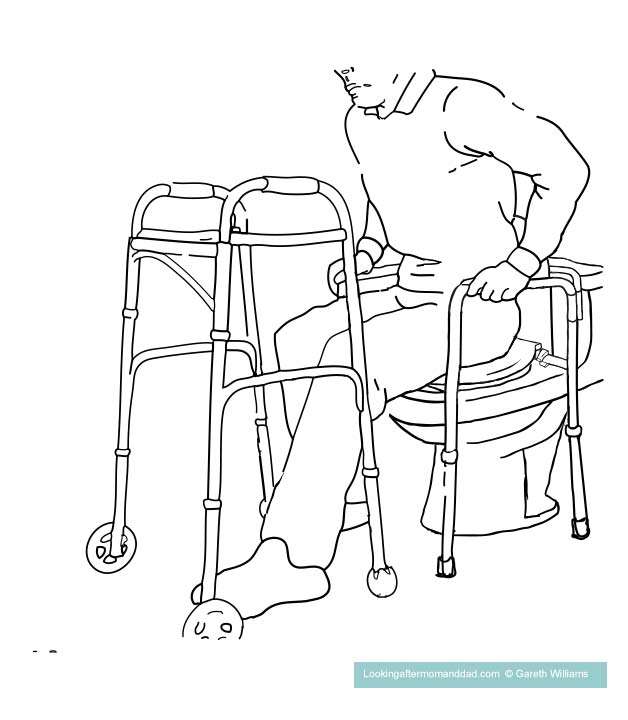
Step 6
Now use your arms to scoot your self back from the front edge of the raised toilet seat, so you are sitting on it properly – again don’t lean forwards to do this, just take your weight with your arms and use your good leg to help them push you back a little.
To stand back up
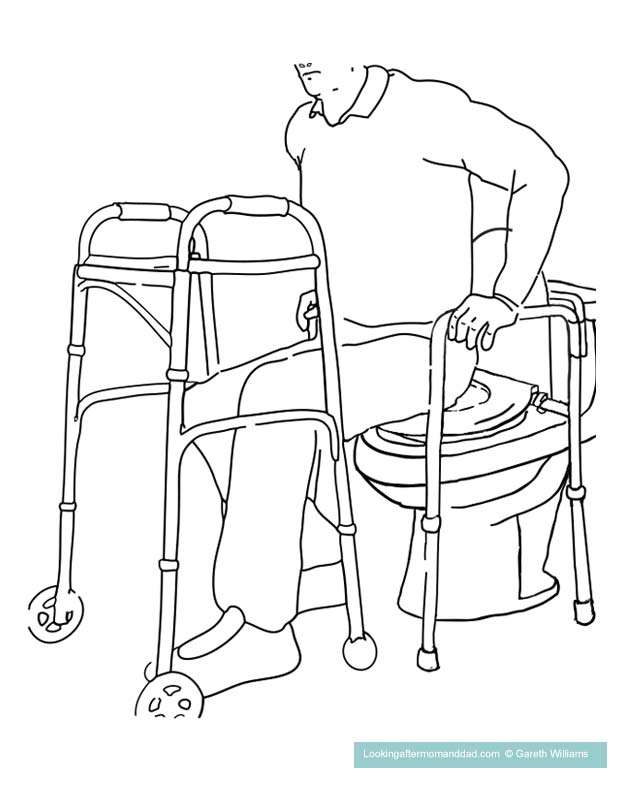
Step 1
Take hold of both armrests, and scoot yourself to the front edge of the raised toilet seat – keep your back straight, do not lean forwards, and use your arms to take your weight and to move you forwards.
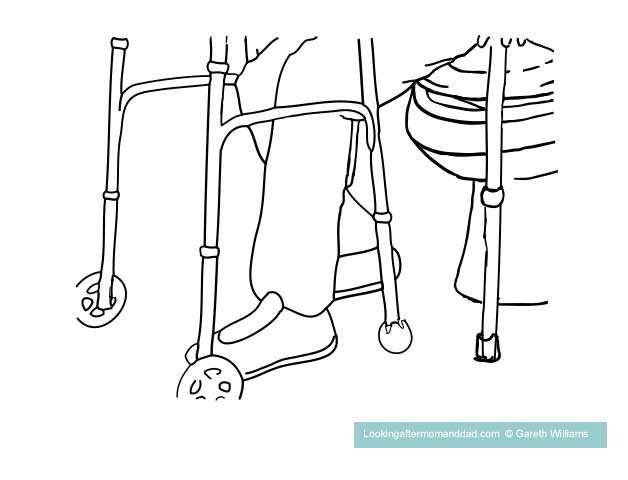
Step 2
You are about to stand, but first make sure that your good leg is bent back slightly back and under you, so that your foot is tucked slightly further back than usual – the idea is that your good leg will be able to provide more force, from this position, without causing you to lean forwards and break the 90 degree rule as you stand, and it is tucked under you a little, and not so far out in front of you.
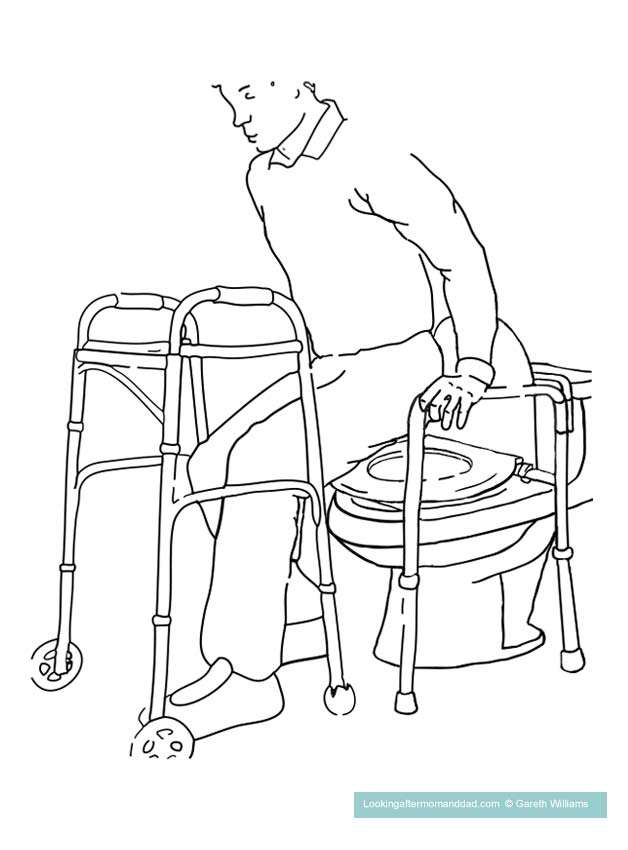
Step 3
Push up with your arms and good leg, keeping your back straight, and trying not to lean forwards.
Don’t push up with your operated leg, this should be extended out in front of you, and not load bearing as you stand up.
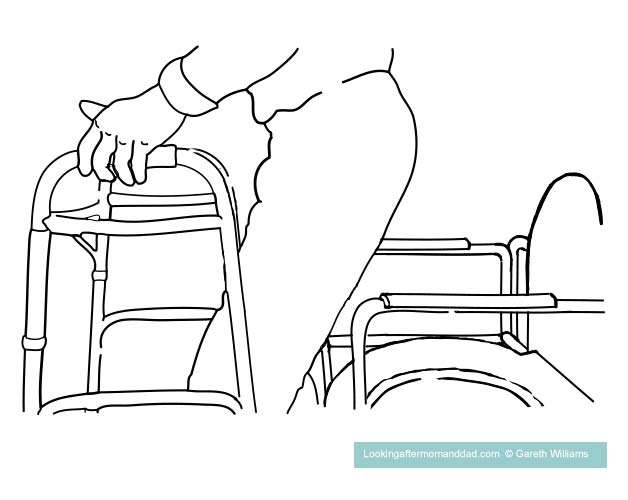
Step 4
As you stand, once you have fully pushed your arms up, take hold of the walker with your hand on the side of the operated leg, while you are still holding the armrest of the raised toilet seat with the other hand.
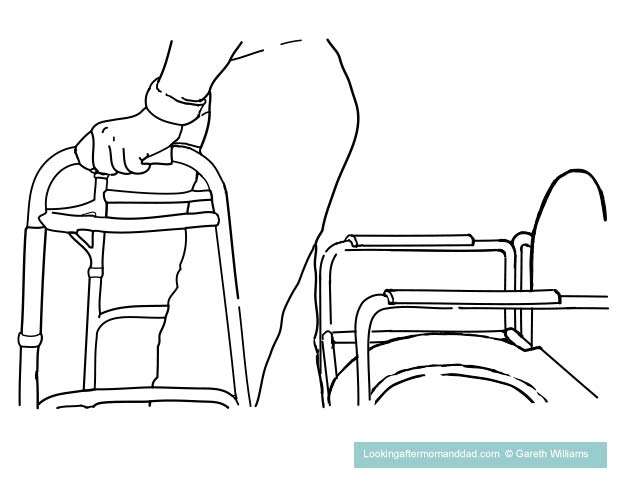
Step 5
You can now take hold on the walker with your other hand.
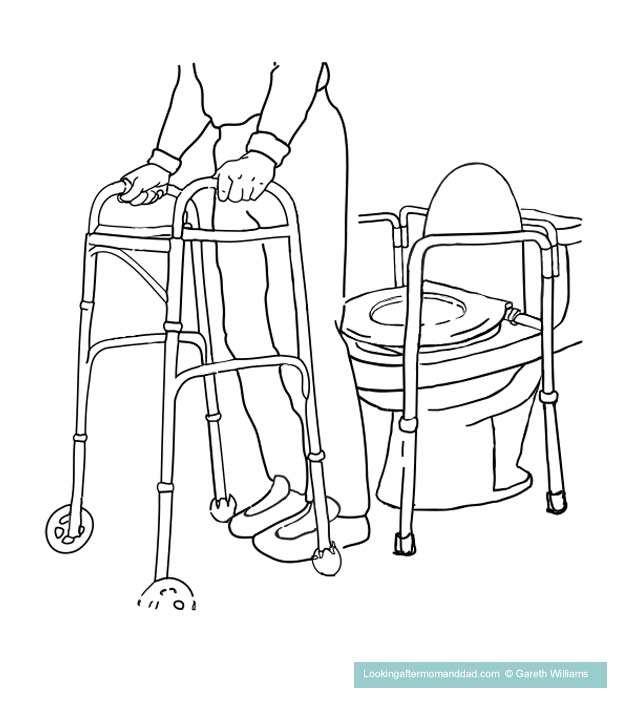
Step 6
With your hands now both on the walker, and your weight firmly on your good leg, you can bring the operated leg back into its normal position, instead of extended out in front of you, and stand normally, but taking care to not put much weight on the operated leg at first.
Does Medicare cover raised toilet seats ?
Medicare Part B does not cover raised toilet seats for use in the home.
Raised toilet seats are not seen as “medically necessary” by Medicare, and are classed as “not primarily medical in nature”.
Some Medicare Advantage Plans, though, may offer coverage for raised toilet seats, as they are now allowed to offer extra benefits for equipment which helps with chronic conditions, and some bathroom equipment is allowed.
Although Medicare Part B will not cover raised toilet seats, it does cover bedside commodes for those who qualify under its guidelines.
If you would like to find out more about how to get coverage from Medicare Part B for a bedside commode, you can read my article all about the guidelines and qualification for bedside commodes here – “Does Medicare cover bedside commodes ?”
How to choose a raised toilet seat
If you need to know more about the different types of raised toilet seats that exist, how they fix to the toilet, or over it, and how they compare, you can find all that information, and more, in my article “Types Of Raised Toilet Seats: All You Should Know Before You Buy”.
To choose a raised toilet seat which is suitable for you, or a loved one, you want to consider
Points about the equipment itself –
- does the user need any particular features ?
- the size and weight capacity of the seat required
- does the intended user know how to sit using a walker ?
- is it for long, medium, or short-term use ?
Points about the space and intended user –
- the space where it is going ? Clutter ? Access ?
- the state of health of the user
- any specific medical conditions
You need to ask yourself a certain number of questions to help refine your choice of raised toilet seat –
The bathroom space
- how much room do you have ?
- can it be more clutter-free ?
- will the user need extra grab bars, and a walker ?
What kind of shape is the user in ?
- how strong ?
- how old ?
- are there balance and mobility issues ?
- are they overweight ?
- are they really tall ?
- are they very nervous ?
Are there specific medical issues ?
- are there medical issues which will affect your choice ?
- do you need to talk to the user’s medical provider ?
- are there visual impairments ?
- is this for a post surgery rehab ?
These are just a few of the questions which will hopefully get your thinking juices flowing, and help you along.
If you want to learn more, you can go to my post, “How To Choose A Raised Toilet Seat ?”.
The post has lots more information on the features that you want to consider on the different seats, and a free Raised Toilet Seat Checklist full of questions that you can use to help you make your choice.
I’m Gareth, the author and owner of Looking After Mom and Dad.com
I have been a caregiver for over 10 yrs and share all my tips here.

